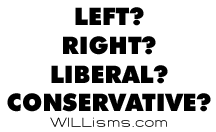Sunday, October 16, 2005
Canada's political cliques
 In the September 30, 2005 edition of the National Post (there would be a link except the national papers are jerks and require pay subscriptions for that), the paper ran highlights of a Dominion Institute and Innovative Research Group poll examining how Canadian's political views can be catorgized into five main groups. The piece was part of a weeklong series examining the future of Conservatism in Canada.
In the September 30, 2005 edition of the National Post (there would be a link except the national papers are jerks and require pay subscriptions for that), the paper ran highlights of a Dominion Institute and Innovative Research Group poll examining how Canadian's political views can be catorgized into five main groups. The piece was part of a weeklong series examining the future of Conservatism in Canada.The instalment in question sheds some light on why the Conservative Party of Canada is struggling to connect with the majority of Canadians. Less than one in five Canadians were identified as "Traditional Conservatives." This is the group that the Reform, Alliance and Conservative Parties have constantly courted and never really paid anything more than lip service to any other interested cliques - to be examined later.
Traditional Conservatives (17% of respondents) are defined as: Socially conservative, strongly believe that the traditional family suffers when women work (although they are often the biggest boosters of capitalism where everything is consume, consume and more consumption which usually requires two incomes to afford today's toys), and also feel strongly that same-sex relationships are morally wrong.
This groups is unlikely to believe government should set community moral standards and feel that all prosper when business prospers and don't like red tape. This group is split on whether government should live within its means. They tend to include a significant minority - one-third - who believe a key role of government is to redistribute wealth. This group is strongest in western Canada, particularly the rural areas and large parts of Southern Alberta.
“Traditional Conservatives”, when successful, reach out to Responsible Capitalists (19%). The Traditionalists have largely shunned this group in recent years. "Responsible Capitalists" are Blue Liberals - the future supports of former Finance Minister and future Liberal leadership candidate John Manley. They are friendly to business, but not blindly loyal. Believing that business regulation is necessary and that government should spend on the public's ability to pay.
"Responsible Capitalists" are almost all pro-environment, with more than two-thirds picking the environment over the economy. This group tends to be older, richer and more male than average. The prime example here is the B.C. conservative (provincially Liberal). This group is fiscally conservative, but socially liberal. They get scared when folks continuously debate Abortion over Research and Development or Capital Gains.
The "Show Me Left" (19%) is the other group that the Conservative party could potentially cherry pick support from. This group tends to be overwhelmingly female and want an active government, but are sceptical of business, government and some people that the social safety net is intended for. They are likely to agree that people who don't get ahead should blame themselves, not the system. They are religious, but are socially liberal.
The two other groups are where the 3 remaining federal political parties draw their support. The Social Democrats (25%) and the "Small "l" Liberals" (21%) are where the Liberal Party of Canada, the Bloc Quebecois and the NDP get significant support.
"Social Democrats" believe a key role of government is to redistribute wealth and want government to keep a firm hand on business. This group is socially liberal and moderately environmentalist. They tend to be younger and include more than one-third of Quebec. This group is a write off for the Conservatives.
"The Small "l" Liberals" are smack in the middle of the political spectrum, but have plenty in common with their cousins on the left. They reject wealth redistribution, but are keen to see government spending based on need. They are sceptical of business, want to regulate corporate power and support environmental concerns over economic ones by a factor of two-to-one. This includes one quarter of Ontarians. This group shares some concerns with the Conservatives and may slip over to that side in the ballot box given the right leader and set of policies.
The Canadian political landscape actually shows that the Conservative Party of Canada and Conservatism have a future in the country. The key is for the movement to broaden its appeal by talking to the masses not the converts. Recent announcements targeting middle-income tax relief are a good start. Reaching out the working, blue-collar worker has proven widely successful for the Republicans in the United States.